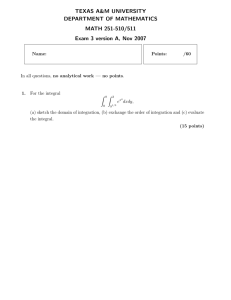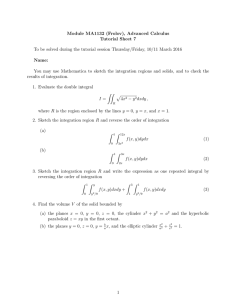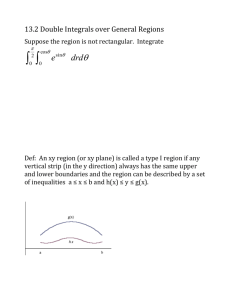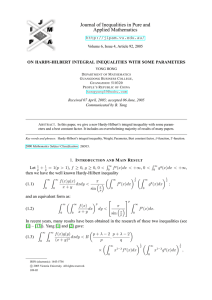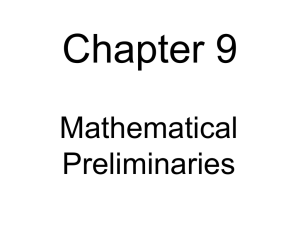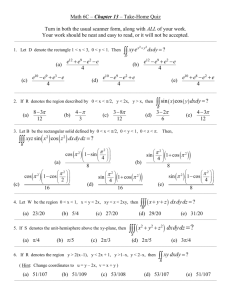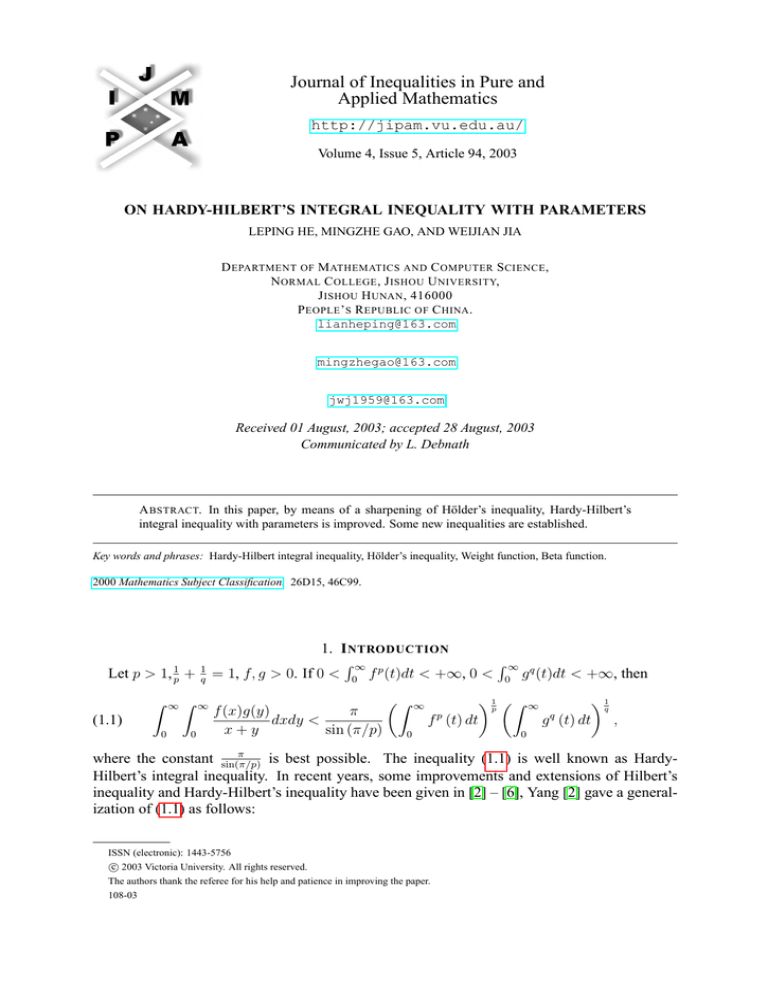
Journal of Inequalities in Pure and
Applied Mathematics
http://jipam.vu.edu.au/
Volume 4, Issue 5, Article 94, 2003
ON HARDY-HILBERT’S INTEGRAL INEQUALITY WITH PARAMETERS
LEPING HE, MINGZHE GAO, AND WEIJIAN JIA
D EPARTMENT OF M ATHEMATICS AND C OMPUTER S CIENCE ,
N ORMAL C OLLEGE , J ISHOU U NIVERSITY,
J ISHOU H UNAN , 416000
P EOPLE ’ S R EPUBLIC OF C HINA .
lianheping@163.com
mingzhegao@163.com
jwj1959@163.com
Received 01 August, 2003; accepted 28 August, 2003
Communicated by L. Debnath
A BSTRACT. In this paper, by means of a sharpening of Hölder’s inequality, Hardy-Hilbert’s
integral inequality with parameters is improved. Some new inequalities are established.
Key words and phrases: Hardy-Hilbert integral inequality, Hölder’s inequality, Weight function, Beta function.
2000 Mathematics Subject Classification. 26D15, 46C99.
Let p > 1, p1 +
Z
∞
Z
(1.1)
0
0
1
q
∞
1. I NTRODUCTION
R∞
R∞
= 1, f, g > 0. If 0 < 0 f p (t)dt < +∞, 0 < 0 g q (t)dt < +∞, then
f (x)g(y)
π
dxdy <
x+y
sin (π/p)
Z
∞
p1 Z
f (t) dt
0
p
∞
1q
g (t) dt ,
q
0
π
is best possible. The inequality (1.1) is well known as Hardywhere the constant sin(π/p)
Hilbert’s integral inequality. In recent years, some improvements and extensions of Hilbert’s
inequality and Hardy-Hilbert’s inequality have been given in [2] – [6], Yang [2] gave a generalization of (1.1) as follows:
ISSN (electronic): 1443-5756
c 2003 Victoria University. All rights reserved.
The authors thank the referee for his help and patience in improving the paper.
108-03
2
L EPING H E , M INGZHE G AO ,
AND
W EIJIAN J IA
If λ > 2 − min{p, q}, α < T 6 ∞ then
Z TZ T
f (x)g(y)
(1.2)
dxdy
λ
α
α (x + y − 2α)
#
) p1
(Z "
p+λ−2
T
p
t−α
(t − α)1−λ f p (t)dt
<
kλ (p) − θλ (p)
T
−
α
α
#
) 1q
(Z "
q+λ−2
T
q
t−α
kλ (p) − θλ (q)
(t − α)1−λ g q (t)dt
×
T
−
α
α
(T < ∞)
and
Z
∞
Z
∞
(1.3)
α
α
f (x)g(y)
dxdy
(x + y − 2α)λ
Z
< kλ (p)
∞
p1 Z
(t − α)1−λ f p (t)dt
α
∞
1q
(t − α)1−λ g q (t)dt ,
α
where
p+λ−2 q+λ−2
kλ (p) = B
,
,
p
q
(2−λ)/r
Z 1
1
1
du
θλ (r) =
λ
u
0 (1 + u)
(r = p, q).
The main purpose of this paper is to build a few new inequalities which include improvements
of the inequalities (1.2) and (1.3), and extensions of corresponding results in [3] – [5].
2. L EMMAS AND THEIR P ROOFS
For convenience, we firstly introduce some notations:
Z T
p1
Z T
r
s
r
s
p
(f , g ) =
f (x)g (x) dx, kf kp =
f (x) dx ,
α
kf k2 = kf k .
α
We next introduce a function defined by
Sr (H, x) = H r/2 , x kHk−r/2
,
r
where x is a parametric variable vector which is a variable unit vector. Under the general case,
it is properly chosen such that the specific problems discussed are simplified.
Clearly, Sr (H, x) = 0 when the vectornx selected
is orthogonal to H p/2 . Throughout this
o
paper, the exponent m indicates m = min p1 , 1q , α < T 6 ∞.
In order to verify our assertions, we need to build the following lemmas.
Lemma 2.1. Let f (x) , g (x) > 0,
+∞, then
(2.1)
1
p
+
1
q
= 1 and p > 1. If 0 < kf kp < +∞ and 0 < kgkq <
(f, g) < kf kp kgkq (1 − R)m ,
where R = (Sp (f, h) − Sq (g, h))2 , khk = 1, f p/2 (x), g q/2 (x)and h(x) are linearly independent.
J. Inequal. Pure and Appl. Math., 4(5) Art. 94, 2003
http://jipam.vu.edu.au/
O N H ARDY-H ILBERT ’ S I NTEGRAL I NEQUALITY WITH PARAMETERS
3
Proof. First of all, we discuss the case of p 6= q. Without loss of generality, suppose that
p
p > q > 1, since p1 + 1q = 1, we have p > 2. Let R = p2 , Q = p−2
. Then R1 + Q1 = 1. By
Hölder’s inequality we obtain,
Z T
(2.2)
(f, g) =
f (x)g (x) dx
a
Z T
=
f · g q/p g 1−(q/p) dx
a
Z
T
f ·g
6
q/p R
R1 Z
T
g
dx
1−(q/p) Q
Q1
dx
a
a
= f p/2 , g q/2
p2
q (1− p2 )
kgkq
.
And the equality in (2.2) holds if and only if f p/2 and g q/2 are linearly dependent. In fact, the
R
Q
equality in (2.2) holds if and only if, there exists a c1 such that f · g q/p = c1 g 1−(q/p) . It
is easy to deduce that f p/2 = c1 g q/2 .
In our previous paper [3], with the help of the positive definiteness of the Gram matrix, we
established an important inequality of the form
(α, β)2 6 kαk2 kβk2 − (kαk x − kβk y)2 = kαk2 kβk2 (1 − γ)
2
y
x
where γ = kαk − kβk , x = (β, γ) , y = (α, γ) with kγk = 1 and xy > 0. The equality in
(2.3) holds if and only if α and β are linearly dependent; or the vector γ is a linear combination
of α and β, and xy = 0 but x 6= y. If α, β and γ in (2.3) are replaced by f p/2 , g q/2 and h
respectively, then we get
2
(2.4)
f p/2 , g q/2 6 kf kpp kgkqq (1 − R) ,
(2.3)
where R = (Sp (f, h) − Sq (g, h))2 with ||h|| = 1. The equality in (2.4) holds if and only
if f p/2 and
g q/2 are
linearly dependent,
or h is a linear combination of f p/2 and g q/2 , and
f p/2 , h g q/2 , h = 0, but f p/2 , h 6= g q/2 , h . Since f p/2 and g q/2 are linearly independent, it is impossible to have equality in (2.4). Substituting (2.4) into (2.2), we obtain after
simplifications
1
(f, g) < kf kp kgkq (1 − R) p .
(2.5)
Provided that h(x) is properly chosen, then R 6= 0 is achieved. (The choice of h(x) is quite
flexible, as long as condition khk = 1 is satisfied, on which we can refer to [3, 4], etc.). Noticing
the symmetry of p and q, the inequality (2.1) follows from (2.5).
Next, we discuss the case of p = q. According to the hypothesis: when f, g and h are linearly
independent, we immediately obtain from (2.3) the following result:
1
(f, g) < kf k kgk (1 − r̄) 2 ,
where r̄ =
(f,h)
kf k
−
(g,h)
kgk
2
, and khk = 1. Thus the lemma is proved.
Lemma 2.2. Let p > 1, p1 + 1q = 1, λ > 2 − min{p, q}, α < T < ∞. Define the weight function
ωλ as follows:
2−λ
Z T
1
x−α r
(2.6)
ωλ (α, T, r, x) =
dy x ∈ (α, T ].
λ
y−α
α (x + y − 2α)
J. Inequal. Pure and Appl. Math., 4(5) Art. 94, 2003
http://jipam.vu.edu.au/
4
L EPING H E , M INGZHE G AO ,
AND
W EIJIAN J IA
Setting ωλ (α, ∞, r, x) = limT →∞ ωλ (α, T, r, x) and kλ (p) = B
Z
1
θλ (r) =
(2.7)
0
1
(1 + u)λ
p+λ−2 q+λ−2
, q
p
(2−λ)(1−1/r)
1
du,
u
,
(r = p, q),
then we have
(2.8)
ωλ (α, ∞, r, x) = kλ (p)(x − α)1−λ ,
x ∈ (α, ∞)
and
(2.9)
ωλ (α, T, r, x) <
kλ (p) − θ(r)
x−α
T −α
1+(λ−2)(1−1/r) !
(x − α)1−λ ,
x ∈ (α, T ),
where B(m, n) is the beta function.
The proof of this lemma is given in the paper [2]; it is omitted here.
3. M AIN R ESULTS
In order to state it conveniently, we need again to define the functions and introduce some
notations
2−λ
2−λ
f (x)
x − α pq
g(y)
y − α pq
F =
, G=
,
(x + y − 2α)λ/p y − α
(x + y − 2α)λ/q x − α
T
Z
Z
T
F p/2 hT dxdy
Sp (F, hT ) =
α
T
Z
α
Z
G
α
q/2
Z
T
T
Z
α
T
Sq (G, hT ) =
T
Z
F p dxdy
,
α
Z
− 21
T
hT dxdy
α
− 21
q
G dxdy
α
,
α
where hT = hT (x, y) is a unit vector with two variants, namely
Z T Z T
12
2
||hT || =
hT dxdy
= 1, α < T 6 ∞,
α
α
and F p/2 , Gq/2 , hT are linearly independent.
Theorem 3.1. Let p > 1,
1
p
+
1
q
= 1, λ > 2 − min {p, q}, α < T 6 ∞, f (t), g(t) > 0. If
Z
∞
0<
Zα∞
0<
(t − α)1−λ f p (t) dt < +∞
and
(t − α)1−λ g q (t) dt < +∞,
α
then
(i) For T < ∞, we have
Z TZ T
f (x)g(y)
(3.1)
dxdy
λ
α
α (x + y − 2α)
(Z
) p1
(p+λ−2)/p !
T
t−α
kλ (p) − θλ (p)
<
(t − α)1−λ f p (t)dt
T
−
α
α
J. Inequal. Pure and Appl. Math., 4(5) Art. 94, 2003
http://jipam.vu.edu.au/
O N H ARDY-H ILBERT ’ S I NTEGRAL I NEQUALITY WITH PARAMETERS
(Z
T
×
kλ (p) − θλ (q)
α
t−α
T −α
5
) 1q
(q+λ+2)/q !
(t − α)1−λ g q (t)dt
(1 − RT )m ,
where
p+λ−2 q+λ−2
kλ (p) = B
,
,
p
q
2−λ
Z 1
1 r
1
θλ (r) =
du (r = p, q).
λ
u
0 (1 + u)
(ii) For T = ∞, we have
∞
Z
∞
Z
f (x)g(y)
dxdy
(x + y − 2α)λ
α
Z ∞
p1 Z
< kλ (p)
(t − α)1−λ f p (t)dt
(3.2)
α
α
∞
1q
(t − α)1−λ g q (t)dt (1 − R∞ )m ,
α
where RT = (Sp (F, hT ) − Sq (G, hT ))2 ,
1
1
ea−x
x−a 4
2 2
, T = ∞;
1
π
(x + y − 2a) 2 y − a
hT (x, y) =
T −α
T −α
T −α
e(1− 2(x−α) − 2(y−α) ) , T < ∞.
(x − α)(y − α)
(3.3)
Proof. By Lemma 2.1, we get
Z
T
Z
T
(3.4)
α
α
f (x)g(y)
dxdy
(x + y − 2α)λ
Z TZ T
=
F Gdxdy
α
α
T
Z
Z
T
p
p1 Z
T
Z
F dxdy
6
α
T
Z
=
1q
T
q
G dxdy
α
α
α
p1 Z
p
ωλ (α, β, q, t)f (t) dt
α
(1 − RT )m
T
1q
ωλ (α, β, p, t)g (t) dt (1 − RT )m ,
q
α
where ωλ (α, T, r, t) (r = p, q) is the function defined by (2.6) .
Now notice that θλ (p) = θλ (q), θλ (q) = θλ (p) and substituting (2.9) and (2.8) into (3.4)
respectively, the inequalities (3.1) and (3.2) follow.
It remains to discuss the expression of RT . We may choose the function hT indicated by
(3.3).
When T = ∞, setting s = x − α, t = y − α, then
Z
∞
Z
∞
||h∞ || =
α
h2∞ (x, y)dxdy
α
J. Inequal. Pure and Appl. Math., 4(5) Art. 94, 2003
21
Z ∞
Z ∞
s 12 12
2
1
=
dt
= 1.
e−2s ds
π 0
s+t t
0
http://jipam.vu.edu.au/
6
L EPING H E , M INGZHE G AO ,
AND
W EIJIAN J IA
−α
−α
When T < ∞, setting ξ = Tx−α
, η = Ty−α
, then we have
Z T Z T
12
khT k =
h2T dxdy
α
α
12
Z T
−α
−α
T − α (1− Tx−α
T − α (1− Ty−α
)
)
dy
dx ·
e
=
e
2
2
α (y − α)
α (x − α)
Z ∞
21
Z ∞
1−ξ
1−η
=
e dξ ·
e dη
= 1.
Z
T
1
1
According to Lemma 2.1 and the given hT , we have RT = (Sp (F, hT ) − Sq (G, hT ))2 . It is
obvious that F p/2 , Gq/2 and hT are linearly independent, so it is impossible for equality to hold
in (3.4). Thus the proof of theorem is completed.
Remark 3.2. Clearly, the inequalities (3.1) and (3.2) are the improvements of (1.2) and (1.3)
respectively .
Owing to p, q > 1, when λ = 1, 2, 3, the condition λ > 2 − min(p, q) is satisfied, then we
have
γ1
Z 1
Z 1
1
1
1
1 1
π
θ1 (r) =
du >
du = ln 2, k1 (p) = B
,
=
,
u
q p
sin(π/p)
0 1+u
0 1+u
Z 1
1
p+2−2 q+2−2
1
θ2 (r) =
k2 (p) = B
,
= B(1, 1) = 1,
2 du = ,
2
p
q
0 (1 + u)
− γ1
Z 1
Z 1
1
u
1
1
du >
du
=
,
θ3 (r) =
3
3
u
8
0 (1 + u)
0 (1 + u)
1
1 1
(p − 1)π
k3 (p) =
B
,
= 2
.
2pq
q p
2p sin(π/p)
By Theorem 3.1, some corollaries are established as follows:
RT
Corollary 3.3. If p > 1, p1 + 1q = 1, λ = 1, α < T 6 ∞ and f (t), g(t) > 0, 0 < α f p (t)dt <
RT
+∞ and 0 < α g q (t)dt < +∞ , then we have
Z TZ T
f (x)g(y)
(3.5)
dxdy
α
α x + y − 2α
(Z
!
) p1
1
T
π
t−α q
· ln 2 f p (t)dt
<
−
sin(π/p)
T
−
α
α
(Z
!
) 1q
1
T
π
t−α p
×
−
· ln 2 · g q (t)dt
(1 − r1 )m , for T < ∞,
sin(π/p)
T
−
α
α
and
Z
∞
Z
∞
(3.6)
α
α
f (x)g(y)
π
dxdy <
x + y − 2α
sin(π/p)
Z
∞
α
p1 Z
f (t)dt
∞
p
1q
g (t)dt (1 − r1 )m .
q
α
Remark 3.4. When α = 0 and p = q = 2, the inequality (3.6) is reduced to a result which
is equivalent to inequality (3.1) in [3] after simple computations. As a result, the inequalities
(3.1), (3.2) and (3.5) – (3.6) are all extensions of (3.1) in [3].
J. Inequal. Pure and Appl. Math., 4(5) Art. 94, 2003
http://jipam.vu.edu.au/
O N H ARDY-H ILBERT ’ S I NTEGRAL I NEQUALITY WITH PARAMETERS
Corollary 3.5. Let p > 1,
then we obtain
Z TZ T
(3.7)
α
1
p
7
1
q
= 1, α < T 6 ∞ and f (t), g(t) > 0. If
Z T
1
f p (t) dt < +∞ and
0<
t
−
α
α
Z T
1 q
0<
g (t) dt < +∞,
α t−α
+
f (x)g(y)
dxdy
(x + y − 2α)2
Z T p1
t−α
1
· f p (t)dt
<
1−
2
(T
−
α)
t
−
α
α
1q
Z T 1
t−α
q
· g (t)dt (1 − r2 )m , for T < ∞,
×
1−
2
(T
−
α)
t
−
α
α
α
and
∞
Z
Z
∞
(3.8)
α
α
f (x)g(y)
dxdy
(x + y − 2α)2
Z ∞
p1 Z ∞
1q
1 q
1
p
<
f (t)dt
g (t)dt (1 − r2 )m .
t
−
α
t
−
α
α
α
Corollary 3.6. If p > 1,
then we get
Z TZ
(3.9)
1
p
+
1
q
= 1, λ = 3, α < T 6 ∞ and f (t), g(t) > 0,
Z T
1
0<
f p (t)dt < +∞,
2
α (t − α)
Z T
1
0<
g q (t)dt < +∞,
2
(t
−
α)
α
T
f (x)g(y)
dxdy
3
α
α (x + y − 2α)
(Z
) p1
1+ p1 !
T
(p − 1)π
1 t−α
1
<
−
f p (t)dt
2
2
2p sin(π/p) 8 T − α
(t − α)
α
(Z
) 1q
1+ 1q !
T
(p − 1)π
1 t−α
1
×
−
g q (t)dt
(1 − r3 )m
2
2
2p sin(π/p) 8 T − α
(t − α)
α
T < ∞,
and
Z
∞
Z
∞
(3.10)
α
α
p1
1
p
f (t)dt
(t − α)2
α
Z ∞
1q
1
q
×
g (t)dt (1 − r3 )m .
2
(t
−
α)
α
f (x)g(y)
(p − 1)π
dxdy < 2
3
(x + y − 2α)
2p sin(π/p)
Since kλ (2) = B
λ λ
,
2 2
, θλ (2) = 12 B
J. Inequal. Pure and Appl. Math., 4(5) Art. 94, 2003
λ λ
,
2 2
Z
∞
, and λ > 2 − min(2, 2) = 0, we also have
http://jipam.vu.edu.au/
8
L EPING H E , M INGZHE G AO ,
AND
W EIJIAN J IA
Corollary 3.7. If p = q = 2, λ > 0, α < T 6 ∞ and f (t), g(t) > 0,
Z T
0<
(t − α)1−λ f 2 (t) dt < +∞,
α
Z T
0<
(t − α)1−λ g 2 (t) dt < +∞,
α
then we have
Z TZ
(3.11)
α
T
f (x)g(y)
dxdy
(x + y − 2α)λ
) 12
(Z T "
λ/2 #
1 t−α
λ λ
1−
(t − α)1−λ f 2 (t)dt
<B
,
2 2
2
T
−
α
α
(Z "
) 12
λ/2 #
T
1 t−α
×
1−
(t − α)1−λ g 2 (t)dt
(1 − R)m , for T < ∞
2
T
−
α
α
α
and
Z
(3.12)
∞
Z
∞
f (x)g(y)
dxdy
(x + y − 2α)λ
Z ∞
12 Z ∞
21
λ λ
1−λ 2
1−λ 2
e m.
,
(t − α)
f (t)dt
<B
(t − α)
g (t)dt (1 − R)
2 2
α
α
α
α
Remark 3.8. The inequalities (3.11), (3.12) are new generalizations of (20) in [4] and improvements of the inequalities (4) and (12) in [6] respectively.
R EFERENCES
[1] G.H. HARDY, J.E. LITTLEWOOD
bridge, UK, 1952.
AND
G. POLYA, Inequalities, Cambridge Univ. Press, Cam-
[2] BICHENG YANG, On Hardy-Hilbert’s integral inequality, J. Math. Anal. Appl., 261 (2001), 295–
306.
[3] MINGZHE GAO, LI TAN AND L. DEBNATH, Some improvements on Hilbert’s integral inequality,
J. Math. Anal. Appl., 229 (1999), 682–689.
[4] MINGZHE GAO, On the Hilbert inequality, Zeitschrift für Analysis und ihre Anwendungen, 18(4)
(1999), 1117–1122.
[5] MINGZHE GAO, SHANG RONG WEI AND LEPING HE, On the Hilbert inequality with weights,
Zeitschrift für Analysis und ihre Anwendungen, 21(1) (2002), 257–263.
[6] BICHENG YANG, On Hilbert’s integral inequality, J. Math. Anal. Appl., 220 (1998), 778–785.
J. Inequal. Pure and Appl. Math., 4(5) Art. 94, 2003
http://jipam.vu.edu.au/

